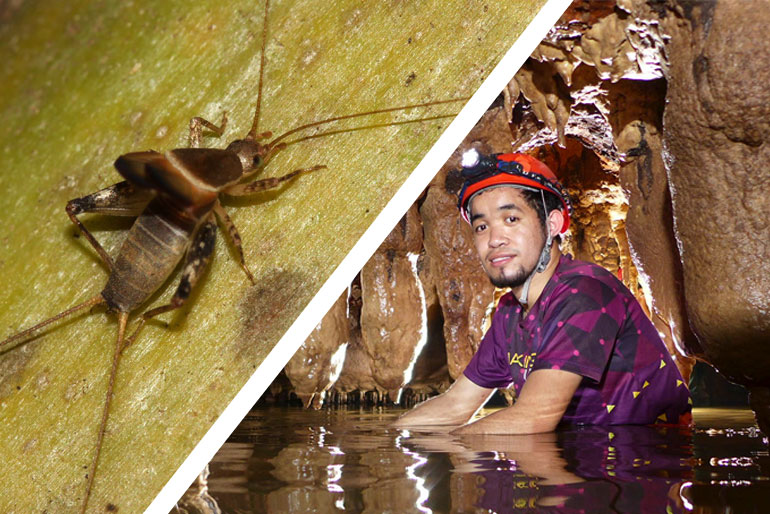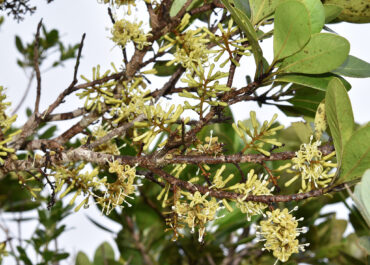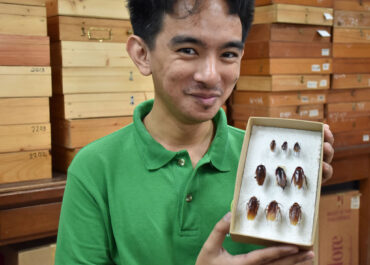
I was not surprised at all when I heard that a new species of cricket was named after a very good friend. The publication had good timing, released online just three days before what should have been his 28th birthday. Today, May 8 marks five months since he has passed on.
The description of James’ scaly cricket, Ornebius alvarezi sp. nov., one of two new species of common scaly crickets recently described from Siargao Island in Mindanao is both a testament and honor given to James Alvarez, a promising young wildlife biologist brimming with so much potential but whose life was probably destined to be just that — short, accomplished and well-lived.
Upon reading the description on Zootaxa (https://doi.org/10.11646/zootaxa.4590.1.7), I was immediately drawn to the photo of the holotype which Ming Kai (Tan), Jeck (Baroga-Barbecho) and Ma’m Sheng (Yap) collected in Siargao, just two months before James’ ill-fated climb of Mt. Apo in December 2018. I looked at it closely from several points of view, and concurred, yes, the new cricket does embody James.
On its tegmen, Ornebius alvarezi has a whitish, milky edge coloration which looks like a band. Unknown most to many, James had a head operation when he was just a small boy – leaving a “permanent headband” on his scalp — a brand which he gamely tells his friends and new acquaintances about.
His father, Nestor, said that operation was able to save James’ life even though it meant that his son would be forced to stay at home and watch his 13 brothers and sisters play more rigorously outside or stay up longer under the sun to work in their family farm. Since he was considered fragile in a sense, James relegated himself to reading, studying and excelling in school while dreaming of achieving the boyhood feats which escaped him — climbing mountains and observing forest life.
In college, he fell in love with biology and was determined to study biodiversity and conservation. Later in life, James got invited to be part of the Gamma Sigma Delta Honor Society of Agriculture, won the 2017 Outstanding Researcher Award (Junior, Natural Sciences category), and became an associate member of the National Research Council of the Philippines.
If you personally knew James, you would really see that he would be happiest when on the field. When he was young, he was frail and easily gets tired outdoors. I remember him saying that fieldwork gave him several firsts in his life, one of which was conquering a fear of heights. When he surmounted that fear, he felt he can do anything — explore deep recesses of caves despite what lurks within, cross mighty rivers and assault 60 degree steep mountains and climb centuries-old trees to observe wildlife in the forest canopy.
Indeed, James was able to do several special things. His cricket too is somewhat special, being only the third species from the genus Ornebius described from the Philippines. There are 115 species of Ornebius known worldwide, but only four, including O. alvarezi has been described from the country. James’ cricket belongs to the orthopteran sub-family Mogoplistinae, hence is relatively small in size and its body covered by tiny scales. These scaly crickets can be found as communities in forest litter, on shrubs and even on canopies.
And speaking of community, James had a knack for involving people, specially the local stakeholders and beneficiaries, in his conservation work. Exuding great passion for teaching and sharing, James has already proven in his study areas that, indeed, biodiversity conservation starts with the people knowing and understanding what there is to protect and conserve.
Dr. Sheryl Yap, one of the scientists which named the cricket after James, shares that the discovery of the new species would not have been possible without the help of the LGU of Del Carmen, Siargao and the Siargao Islands Wildlife Conservation Foundation, Inc. The active involvement of the two organizations and the community partners really help fortify biodiversity conservation and research as a way to sustainable island management.
Much like so, James’ month-long fieldwork in the saw-toothed Mt. Guiting-guiting in Romblon came to success because of his close partnership with the protected area management, the local state university and the members of the community.
****
James’ scaly cricket is truly “James”, I would say. I liken the insect’s scales to that of James’ hairy arms and legs and his bushy hair. I fondly remember a time, I believe it was on a caving trip in Pangasinan, that he asked me to share my tent with him for the night because the trees there were not strong enough to support him in his hammock. Among us, James was known for a notorious sleeping behavior — he would toss and turn in his sleep, rotate like a clock’s arms for most of the night, and this he did inside the one-man tent he shared with me. And to make matters worse, with the spine-tingling rough hairs, he started to, while fully asleep, run his legs against mine. Just like a cricket producing a song. The horror of it.
I fully remember you, James and I will remember your new scaly cricket as well.
Search
Archives
Categories
- Announcement (21)
- Feature (21)
- News (141)
- Press Release (55)
- Research (4)
- Services (3)



